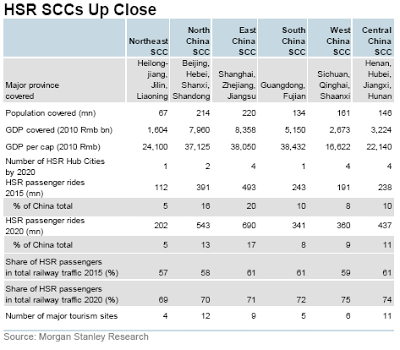

| Visitors Now: | |
| Total Visits: | |
| Total Stories: |

| Story Views | |
| Now: | |
| Last Hour: | |
| Last 24 Hours: | |
| Total: | |
High Speed Rail in China are an enabler of Super City Clusters
From
China's High Speed Rail
Morgan Stanley has a 64 page analysis of high speed rail in China.
China's complete national coverage for its HSR network makes the economic case different than one off HSR lines in California. HSR is about half the cost of a comparable air ticket. There are environmental benefits. China does have very high passenger usage on its lines. This is different that rail usage cases in the USA.
The China HSR system will span 30,000 kilometers, connect more than 250 cities and regions with a total population of about 700 million, mobilize 4 billion travelers per year, and add 1,600 billion kilometers to China’s domestic passenger throughput annually (i.e., four times the total domestic passenger throughput in Japan today) by 2020.
China's rail passenger numbers rose 4.6 percent to 1.7 billion through November, according to the ministry. The numbers have climbed because of the opening of new lines and the easing of safety concerns following a fatal crash last year.
As the China HSR system spreads out and ramps up capacity, regional economic dynamics will change with it. We believe the HSR’s most significant geographical economic impact will be the creation of connected metropolitan areas, or the super-city clusters (SCCs), because of its mass-transporting capacity at very high ground speeds (about 250 to 350 kilometers per hour), basically significantly multiplying a comuter's traveling distance within a fixed time period. Traveling to neighboring cities on HSR will take the same amount of time as traveling across a large city in a car. Eventually we believe that cities within the same cluster, connected by HSR grid, will no longer be conventional stand-alone cities. They will become like huge business-and-life districts in a very large metropolitan area, with active economic interactions.
Will the China HSR project be sustainable? This is clearly a valid question to ask. The operating capital required for such a mega project will be substantial. Our transportation analyst Edward Xu and capital goods analyst Kate Zhu believe that on average every 1,000 kilometers of China HSR will require Rmb4.5 billion per year in operating cash to function (this includes maintenance, parts replacement, and day-to-day operational costs).
On the other hand, the operating revenue, based on our ticket price estimate (using the same per-thousand-kilometer price to per-capita GDP ratio on the eastern portion of the national grid), per-thousand kilometer revenue will be around Rmb6.5 billion per year. This translates into a national operating cash surplus of Rmb2 billion per year, which should be able to cover most, if not all, of the interest expenses.
We believe regional jets will have limited market potential in China and will do well only in those regions where the HSR will not reach, such as the northwest and southwest.
See more and subscribe to NextBigFuture at 2012-12-20 12:47:48 Source: http://nextbigfuture.com/2012/12/high-speed-rail-in-china-are-enabler-of.html
Source:



